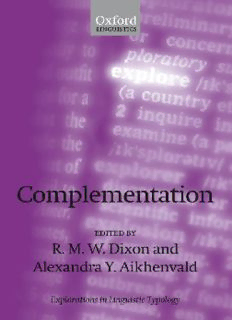
Complementation: A Cross-Linguistic Typoloy (A Sipri Publication) PDF
Preview Complementation: A Cross-Linguistic Typoloy (A Sipri Publication)
Complementation ExplorationsinLinguisticTypology generaleditors AlexandraY.AikhenvaldandR.M.W.Dixon ResearchCentreforLinguisticTypology,LaTrobeUniversity Thisseriesfocusesonaspectsoflanguagethatareofcurrenttheoreticalinterest and for which there has not previously or recently been any full-scale cross- linguisticstudy.Itsbooksarefortypologists,Weldworkers,andtheorydevelop- ers,anddesignedforuseinadvancedseminarsandcourses. published 1 AdjectiveClasses editedby R.M.W.DixonandAlexandraY.Aikhenvald 2 SerialVerbConstructions editedby AlexandraY.AikhenvaldandR.M.W.Dixon 3 Complementation editedby R.M.W.DixonandAlexandraY.Aikhenvald forthcoming 4 GrammarsinContact editedby AlexandraY.AikhenvaldandR.M.W.Dixon publishedinassociationwiththeseries ArealDiVusionandGeneticInheritance ProblemsinComparativeLinguistics editedby AlexandraY.AikhenvaldandR.M.W.Dixon Complementation A Cross-Linguistic Typology Edited by R. M. W. DIXON and ALEXANDRA Y. AIKHENVALD Research Centre for Linguistic Typology La Trobe University 1 3 GreatClarendonStreet,Oxfordox26dp OxfordUniversityPressisadepartmentoftheUniversityofOxford. ItfurtherstheUniversity’sobjectiveofexcellenceinresearch,scholarship, andeducationbypublishingworldwidein OxfordNewYork Auckland CapeTown DaresSalaam HongKong Karachi KualaLumpur Madrid Melbourne MexicoCity Nairobi NewDelhi Shanghai Taipei Toronto WithoYcesin Argentina Austria Brazil Chile CzechRepublic France Greece Guatemala Hungary Italy Japan Poland Portugal Singapore SouthKorea Switzerland Thailand Turkey Ukraine Vietnam OxfordisaregisteredtrademarkofOxfordUniversityPress intheUKandincertainothercountries PublishedintheUnitedStates byOxfordUniversityPressInc.,NewYork (cid:1)EditorialmatterandorganizationR.M.W.DixonandAlexandraY.Aikhenvald2006 (cid:1)Thechapterstheirvariousauthors2006 Themoralrightsoftheauthorhavebeenasserted DatabaserightOxfordUniversityPress(maker) Firstpublished2006 Allrightsreserved.Nopartofthispublicationmaybereproduced, storedinaretrievalsystem,ortransmitted,inanyformorbyanymeans, withoutthepriorpermissioninwritingofOxfordUniversityPress, orasexpresslypermittedbylaw,orundertermsagreedwiththeappropriate reprographicsrightsorganization.Enquiriesconcerningreproduction outsidethescopeoftheaboveshouldbesenttotheRightsDepartment, OxfordUniversityPress,attheaddressabove Youmustnotcirculatethisbookinanyotherbindingorcover andyoumustimposethesameconditiononanyacquirer BritishLibraryCataloguinginPublicationData Dataavailable LibraryofCongressCataloguinginPublicationData Dataavailable TypesetbySPIPublisherServices,Pondicherry,India PrintedinGreatBritain onacid-freepaperby BiddlesLtd.,King’sLynnNorfolk. ISBN0-19-929787-8 978-0-19-929787-0 1 3 5 7 9 10 8 6 4 2 Contents Preface ix Notesoncontributors x Abbreviations xiii 1 ComplementClausesandComplementationStrategiesin TypologicalPerspective 1 R.M.W.Dixon 1 Introduction 1 2 Typesofcomplexsentences 2 3 Corearguments 7 4 Semantictypesofverbs 8 5 Complementclauses 15 6 Semantictypesofverbsandtypesofcomplementclauses 27 7 Complementationstrategies 33 8 Theindividualstudiesinthisvolume 40 9 Conclusion 42 Appendix:notesonterminology 44 References 46 2 ComplementClauseTypesinPennsylvaniaGerman 49 KateBurridge 1 Settingthescene 49 2 Introduction 51 3 Verbtypesandcomplementation 58 4 Concludingremarks:theriseofFERcomplementclauses 68 References 70 3 ComplementClauseTypesinIsraeli 72 Ghil‘adZuckermann 1 Basicinformation 72 2 GrammaticalproWle 73 3 ThediVerencebetweenshe-complementclausesand relativeclauses 76 4 Structuraltypesofcomplementclauses 78 5 Complement-takingverbs 87 vi Contents 6 Secondaryconcepts 91 7 Concludingremarks 91 References 92 4 ComplementClauseTypeandComplementationStrategy in Jarawara 93 R.M.W.Dixon 1 Basicinformation 94 2 GrammaticalproWle 94 3 Structureofacomplementclause 98 4 Complement-takingverbs 110 5 Acomplementationstrategy forindirectspeech 112 6 Conclusion 113 References 114 5 ComplementClauseTypesandComplementationStrategy in WhiteHmong 115 NeridaJarkey 1 Vitalstatistics 115 2 TypologicalproWle 116 3 Furthergrammaticalpreliminaries 117 4 Complementclauses 119 5 Thecomplementationstrategy 129 6 Verbsandverbtypes 131 7 ComparisonofuseofdiVerentcomplementizerswiththe sameverb 131 8 Conclusion 135 References 135 6 ComplementClauseTypesandComplementationStrategy in DolakhaNewar 137 CarolGenetti 1 Thelanguage 137 2 Basicgrammaticalfacts 137 3 Complementclauses 141 4 Complementationstrategy:inWnitiveverbplusgrammatical auxiliary 152 5 Complement-takingverbs 153 6 Secondaryconcepts 156 7 Conclusions 157 References 157 Contents vii 7 ComplementClauseTypesandComplementationStrategiesin Akkadian 159 GuyDeutscher 1 Basicinformation 159 2 TypologicalproWle 160 3 Complementclauses 161 4 Complementationstrategies 170 5 Complement-takingverbs 173 6 Secondaryconcepts 175 7 Historicaldevelopment 176 8 Conclusion 176 References 177 Abbreviationsoftexteditions 177 8 ComplementClauseTypesandComplementationStrategiesin Tariana 178 AlexandraY.Aikhenvald 1 Background 178 2 TypologicalproWleandclausetypes 179 3 Complementclauses 183 4 Complementationstrategies 195 5 Conclusions 201 References 203 9 ComplementClauseTypeandComplementationStrategiesin Goemai 204 BirgitHellwig 1 Typologicalbackground 205 2 Complementation 208 3 Complementationstrategies 215 4 Conclusion 221 References 222 10 ComplementClauseTypeandComplementation StrategiesinMatses 224 DavidW.Fleck 1 Introduction 224 2 TypologicalproWleofMatses 225 3 Thedesiderativecomplementclause:theonly complementclauseinMatses 227 viii Contents 4 Complementationstrategies 233 5 Conclusions 243 References 244 11 ComplementClauseTypeandComplementation Strategy inKambera 245 MarianKlamer 1 Introduction 245 2 Grammaticaloverview 246 3 Majorclausetypes 248 4 Major wordclasses 249 5 Multi-clausalsentences 249 6 Nominalclauses 252 7 Complementationstrategy:controlledclauses 256 8 Perceptionverbsandthequotativeconstruction 259 9 Summaryandconclusions 261 References 262 12 ComplementationStrategiesinDyirbal 263 R.M.W.Dixon 1 Introduction 263 2 Backgroundinformation 264 3 Basicgrammar 267 4 Complementationstrategies 269 5 Discussion 277 References 278 Author index 281 Languageandlanguagefamily index 283 Subjectindex 285 Preface Thisvolumeincludesatypologicalintroduction,plusrevisedversionsoften of the sixteen presentations at the International Workshop on ‘Complement clauses and complementation strategies’, held at the Research Centre for Linguistic Typology, La Trobe University, 16–21 August 2004. Chapter 12, on Dyirbal, has been added in order to include an accountof a language which lacks complement clauses and relies entirely on complementation strategies. AnearlierversionofChapter1hadbeencirculatedtocontributors,toensure that the detailed studies of complementation clauses and complementation strategies in individual languages were cast in terms of the same typological parameters.ThisisthethirdmonographintheseriesExplorationsinlinguistic typology,whichisdevotedtovolumesfromworkshopssponsoredbyRCLT. The weekof the workshopwas an exhilarating experience, with the parti- cipantsassistingeachotherinunderstandingandexplaining how individual languages work, and with the group as a whole coming to grips with the general nature of and mechanisms for complementation. All of the authors havepursuedintensiveinvestigationsoflanguages,someofthemlittleknown intheliterature.Theywereaskedtowriteintermsofbasiclinguistictheory— thecumulativeframeworkinwhichmostdescriptivegrammarsarecast—and to avoid formalisms (which come and go with such frequency that any statementmadeintermsofthemwillsoonbecomedatedandinaccessible). WeoweaspecialdebtofgratitudetoSiewPengCondon,ExecutiveOYcer ofRCLT,fororganizingtheworkshopinamosteYcientandcaringmanner. This volume owes its existence to the vision and care of Professor Michael Osborne, Vice-Chancellor and President of La Trobe University. He sponsored the establishment of RCLT within La Trobe’s Institute for AdvancedStudy,andspeciWedthatitsactivitiesshouldincludeInternational Workshops with stringent quality control. Professor Osborne opens each workshop, launches our volumes, and every year hosts a convivial dinner for theparticipants.
Description: